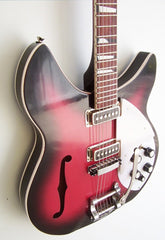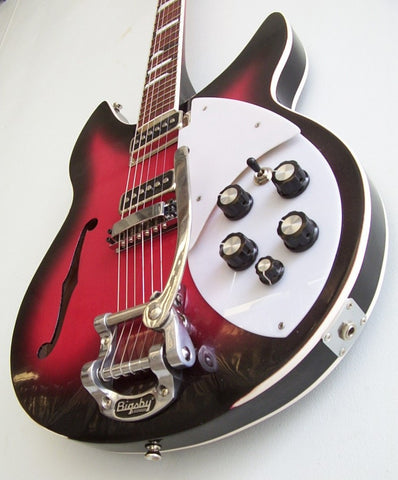Back when I made guitars I was always heavily influenced by two main manufacturers from the US as far as construction and aesthetics went. I love all the crazy Japanese, Italian and British stuff but my first love is (and will always be) Mosrite and I LOVE Rickenbackers.
Their looks and construction is amazing and light years ahead of the competition. The 300 series was launched in 1958 and was like NOTHING else on the market in terms of construction, looks and playability. Semi hollow solid bodies were carved out from the back and then a cap glued on to make essentially a one piece (or two if you count the thin cap) solid timber hollow body guitar. Mosrite played with this idea also as Semie had briefly worked at Ric around this period and his early Mosrites were "hollow solid bodies" which he would revisit several times over the years with models like the production Joe Maphis model.
The hollowed out Ric body had a neck with a VERY long tenon that ran all the way to under the bridge pick up inserted before the back cap was glued on making the necks VERY stable despite the fretboard leaving the body at the last fret. This whole design was absolute genius and compared to Gibsons "long" neck tenon at the time gave incredible strength and stability. The neck/fretboard sits high off the body which is a very German way of making guitars. Mosrite did this also and in the case of Ric meant that the pick ups didn't need to be routed "into" the body but sat on top. Rics do have small recesses for the magnets but the bulk of the pick up sits on top. This height means bridges sit high off the body too and the beautiful concave shaping in the back of the body to accommodate the tailpiece and give more break angle over the bridge is one of my favourite aesthetic design features of these guitars.
Ric made all their own hardware in house so pick ups, bridges and tailpieces are all unique to Ric and until recently have been extremely hard to get anything close. The proliferation of copies on the market has meant that bridges and even pick ups are now commonly available but "R" tailpices still prove very difficult to procure. If you do have a broken one, and I have had several come through my repair section, you can contact Ric, send back your broken one and they will sell you another one to replace it. This keeps the "fake" market at bay pretty well.
So, all of this means that me being the sort of person I am, I wanted to make a Ric to see what made it tick.


As I was kind of obsessed by the workings of the construction I figured I needed to make this like a real one. The Ric process has changed slightly over the years and models have changed slightly so I figured if I was going to make one from scratch I may as well meld all of my favourite parts into one guitar ?
I love the 330 shape (and the 360, and the 381, and the .......) and I own a few of them so I thought Id' start there for the shape and do the beautiful double bound version. I'm not a huge fan of body binding on most guitars but some look great with it and I think the Ric suits binding and inlays. I also like the more traditional "F" hole on the UK Rose Morris versions after drooling over pics of Pete Townshends many over the years. I think the slash F hole Ric uses is great, and again, way ahead of it's time but the rarer traditional F hole looks great on these too.


I didn't build the body exactly like a real Ric as it's a huge waste of nice timber, so I built a "frame" of solid maple similar to the hollow Jag I built for my friend James. It then had a maple laminate on top and back. As the body was double bound the edge of the laminate wouldn't be seen on the final build. The frame was built as close to a real one shape wise (internally) that I could work out from pics of the factory and from taking notes of my personal Rics and from repair work I had done over the years. It's basically the same but rather than routing out all that timber, I could use two pieces of maple and cut the centre sections out and glue it together.


The neck is maple with a walnut strip down the centre like Ric do on some models and the fretboard, like most of my fretboards is jarrah which is similar to rosewood. 330's usually have dot inlays on the fretboard but I LOVE the triangle inlays used on the upper models so I thought I'd do a slight twist on the theme here. I used laminated plastic inlays across the width of the board, like vintage Rics but then radiused the fretboard to show the black under the white giving a duel inlay look. I wasn't sure if it would work but I love it. The neck was then bound like some upper models.
This neck runs all the way back to the bridge pick up, just like a real one and I used the square heel like vintage Rics on the back. It's not as comfortable up high, but I love the way it looks.


The headstock was based on a Ric one but I didn't want to make it exactly as I would never want to pass this off as a real one and this shape seemed to work well ? The Mosrite headstock is almost a small vintage Ric headstock with a "M" cut into the top. Not many people realize that. I added my typical volute as I like the way they feel and add strength to the headstock giving more sustain which Rics can lack from. The famous truss rod cover was borrowed as it really needs this to look "right" but I used the name Tymenbacker with "Made in QLD Australia" instead of "Made in USA"


Once it was all glued together I decided on the red bust as I love it on old Japanese guitars and I had seen a small run of real RM Rics done in this colour scheme and loved it on this shape, especially with the body binding. I decided to do this right through the back of the neck and headstock as well.


I like Bigsby's on Rics and as there was no real alternative to the classic R tailpiece that looks good, I went for that. The bridge is an aftermarket Ric style bridge with cover and the pick ups are DeArmond copies, which are similar in size, look and construction to real Ric pick ups. I have enough real Ric hardware to use the real thing on all of these items but I didn't want to pass it off as a Ric so I was going for "close but not the same" to keep the overall aesthetics going while making sure it played and sounded good.
The two layer scratchplate is, like the originals, white perspex and knobs are generic versions that look close to a style Ric has used at some stage of production over the years.

All in all it was a fun project and gave me a good insight into how a Ric is made and what makes them tick. They are AMAZING guitars and despite common consensus are GREAT for most styles of music and are amazing for mild to heavily distorted punk and rock as witnessed the other night by Joby from the Bronx playing a 360 and of course Guy from Fugazi getting one of the greatest guitar tones in history with a couple of 330's and an old Marshall.
This turned out VERY well and sounds like a Ric ? I've had a few big name players and Ric lovers comment on how good it plays and sounds with one saying it's one of the most Ric sounding Rics he's ever played. I've knocked back offers to make these for people as I don't want them out there. I made this as an experiment and to further my understanding of guitar building by "learning from the best" and I have too much love and respect for Rickenbacker to make these available to anyone else. My advice is if you've never played a nice Ric, go and try one. They are truly amazing instruments and very undervalued in the vintage guitar world and market. It's A LOT of guitar for your buck !!!!
